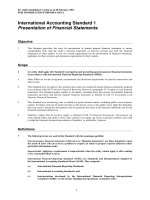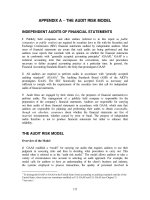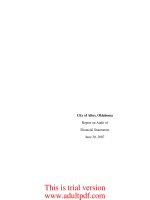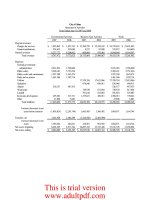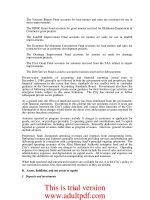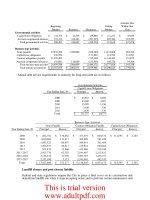CHAPTER 04 ANALYSIS OF FINANCIAL STATEMENTS
Bạn đang xem bản rút gọn của tài liệu. Xem và tải ngay bản đầy đủ của tài liệu tại đây (576.82 KB, 203 trang )
CHAPTER 04—ANALYSIS OF FINANCIAL STATEMENTS
To keep this chapter from involving too much memorization, we provide our students with a formula sheet for use on
exams. That makes a few of the questions trivially easy, but most require some thought, and some are downright
challenging. Even the very easy ones make students think about the ratios. The challenging questions are labeled
CHALLENGING, and most students will agree with that designation.
Some of these questions are just definitions, but others require real thought about the make-up of the ratios and
relationships among the ratios. We tell our students that to answer some of these questions it is useful (1) to write out the
relevant ratio or ratios, (2) then to think about how the ratios would change if the accounting data changed, and (3)
occasionally to make up illustrative data to test their conclusions.
Note that there is some overlap between the True/False and the multiple choice questions, as some T/F statements are
used in the MC questions.
1. Ratio analysis involves analyzing financial statements to help appraise a firm's financial position and strength.
a. True
b. Fals
e
ANSWER:
True
POINTS:
1
DIFFICULTY:
EASY
REFERENCES: 4-1 Ratio Analysis
Cengage Learning Testing, Powered by Cognero
Page 1
CHAPTER 04—ANALYSIS OF FINANCIAL STATEMENTS
LEARNING OBJ FOFM.BRIG.16.04.01 - Ratio Analysis
ECTIVES:
NATIONAL STA United States - BUSPROG.FOFM.BRIG.16.03 - Analytic skills
NDARDS:
United States - BUSPROG.FOFM.BRIG.16.06 - Reflective thinking
STATE STANDA United States - OH - DISC.FOFM.BRIG.16.05 - Financial analysis and cash
RDS:
flows
TOPICS:
Ratio analysis
KEYWORDS:
Bloom’s: Knowledge
2. The current and quick ratios both help us measure a firm's liquidity. The current ratio measures the relationship of the
firm's current assets to its current liabilities, while the quick ratio measures the firm's ability to pay off short-term
obligations without relying on the sale of inventories.
a. True
b. Fals
e
ANSWER:
True
POINTS:
1
DIFFICULTY:
EASY
Cengage Learning Testing, Powered by Cognero
Page 2
CHAPTER 04—ANALYSIS OF FINANCIAL STATEMENTS
REFERENCES: 4-2 Liquidity Ratios
LEARNING OBJ FOFM.BRIG.16.04.02 - Liquidity Ratios
ECTIVES:
NATIONAL STA United States - BUSPROG.FOFM.BRIG.16.03 - Analytic skills
NDARDS:
United States - BUSPROG.FOFM.BRIG.16.06 - Reflective thinking
STATE STANDA United States - OH - DISC.FOFM.BRIG.16.05 - Financial analysis and cash
RDS:
flows
TOPICS:
Liquidity ratios
KEYWORDS:
Bloom’s: Knowledge
3. Although a full liquidity analysis requires the use of a cash budget, the current and quick ratios provide fast and easyto-use estimates of a firm's liquidity position.
a. True
b. Fals
e
ANSWER:
True
POINTS:
1
DIFFICULTY:
EASY
Cengage Learning Testing, Powered by Cognero
Page 3
CHAPTER 04—ANALYSIS OF FINANCIAL STATEMENTS
REFERENCES: 4-2 Liquidity Ratios
LEARNING OBJ FOFM.BRIG.16.04.02 - Liquidity Ratios
ECTIVES:
NATIONAL STA United States - BUSPROG.FOFM.BRIG.16.03 - Analytic skills
NDARDS:
United States - BUSPROG.FOFM.BRIG.16.06 - Reflective thinking
STATE STANDA United States - OH - DISC.FOFM.BRIG.16.05 - Financial analysis and cash
RDS:
flows
TOPICS:
Liquidity ratios
KEYWORDS:
Bloom’s: Knowledge
4. High current and quick ratios always indicate that the firm is managing its liquidity position well.
a. True
b. Fals
e
ANSWER:
False
RATIONALE:
It might have too much liquidity. Liquid assets generally provide low returns.
Cengage Learning Testing, Powered by Cognero
Page 4
CHAPTER 04—ANALYSIS OF FINANCIAL STATEMENTS
POINTS:
1
DIFFICULTY:
EASY
REFERENCES: 4-2 Liquidity Ratios
LEARNING OBJ FOFM.BRIG.16.04.02 - Liquidity Ratios
ECTIVES:
NATIONAL STA United States - BUSPROG.FOFM.BRIG.16.03 - Analytic skills
NDARDS:
United States - BUSPROG.FOFM.BRIG.16.06 - Reflective thinking
STATE STANDA United States - OH - DISC.FOFM.BRIG.16.05 - Financial analysis and cash
RDS:
flows
TOPICS:
Current ratio
KEYWORDS:
Bloom's: Comprehension
5. If a firm sold some inventory for cash and left the funds in its bank account, its current ratio would probably not change
much, but its quick ratio would decline.
a. True
b. Fals
e
ANSWER:
False
Cengage Learning Testing, Powered by Cognero
Page 5
CHAPTER 04—ANALYSIS OF FINANCIAL STATEMENTS
POINTS:
1
DIFFICULTY:
EASY
REFERENCES: 4-2 Liquidity Ratios
LEARNING OBJ FOFM.BRIG.16.04.02 - Liquidity Ratios
ECTIVES:
NATIONAL STA United States - BUSPROG.FOFM.BRIG.16.03 - Analytic skills
NDARDS:
United States - BUSPROG.FOFM.BRIG.16.06 - Reflective thinking
STATE STANDA United States - OH - DISC.FOFM.BRIG.16.05 - Financial analysis and cash
RDS:
flows
TOPICS:
Current and quick ratios
KEYWORDS:
Bloom's: Comprehension
6. If a firm sold some inventory on credit, its current ratio would probably not change much, but its quick ratio would
increase.
a. True
b. Fals
Cengage Learning Testing, Powered by Cognero
Page 6
CHAPTER 04—ANALYSIS OF FINANCIAL STATEMENTS
e
ANSWER:
True
POINTS:
1
DIFFICULTY:
EASY
REFERENCES: 4-2 Liquidity Ratios
LEARNING OBJ FOFM.BRIG.16.04.02 - Liquidity Ratios
ECTIVES:
NATIONAL STA United States - BUSPROG.FOFM.BRIG.16.03 - Analytic skills
NDARDS:
United States - BUSPROG.FOFM.BRIG.16.06 - Reflective thinking
STATE STANDA United States - OH - DISC.FOFM.BRIG.16.05 - Financial analysis and cash
RDS:
flows
TOPICS:
Current and quick ratios
KEYWORDS:
Bloom's: Comprehension
7. If a firm sold some inventory on credit as opposed to cash, there is no reason to think that either its current or quick
ratio would change.
a. True
Cengage Learning Testing, Powered by Cognero
Page 7
CHAPTER 04—ANALYSIS OF FINANCIAL STATEMENTS
b. Fals
e
ANSWER:
False
RATIONALE:
The quick ratio would increase as receivables replaced inventory.
POINTS:
1
DIFFICULTY:
EASY
REFERENCES: 4-2 Liquidity Ratios
LEARNING OBJ FOFM.BRIG.16.04.02 - Liquidity Ratios
ECTIVES:
NATIONAL STA United States - BUSPROG.FOFM.BRIG.16.03 - Analytic skills
NDARDS:
United States - BUSPROG.FOFM.BRIG.16.06 - Reflective thinking
STATE STANDA United States - OH - DISC.FOFM.BRIG.16.05 - Financial analysis and cash
RDS:
flows
TOPICS:
Current and quick ratios
KEYWORDS:
Bloom's: Comprehension
8. The inventory turnover ratio and days sales outstanding (DSO) are two ratios that are used to assess how effectively a
Cengage Learning Testing, Powered by Cognero
Page 8
CHAPTER 04—ANALYSIS OF FINANCIAL STATEMENTS
firm is managing its current assets.
a. True
b. Fals
e
ANSWER:
True
POINTS:
1
DIFFICULTY:
EASY
REFERENCES: 4-3 Asset Management Ratios
LEARNING OBJ FOFM.BRIG.16.04.03 - Asset Management Ratios
ECTIVES:
NATIONAL STA United States - BUSPROG.FOFM.BRIG.16.03 - Analytic skills
NDARDS:
United States - BUSPROG.FOFM.BRIG.16.06 - Reflective thinking
STATE STANDA United States - OH - DISC.FOFM.BRIG.16.05 - Financial analysis and cash
RDS:
flows
TOPICS:
Asset management ratios
KEYWORDS:
Bloom’s: Knowledge
Cengage Learning Testing, Powered by Cognero
Page 9
CHAPTER 04—ANALYSIS OF FINANCIAL STATEMENTS
9. A decline in a firm's inventory turnover ratio suggests that it is improving both its inventory management and its
liquidity position, i.e., that it is becoming more liquid.
a. True
b. Fals
e
ANSWER:
False
POINTS:
1
DIFFICULTY:
EASY
REFERENCES: 4-3 Asset Management Ratios
LEARNING OBJ FOFM.BRIG.16.04.03 - Asset Management Ratios
ECTIVES:
NATIONAL STA United States - BUSPROG.FOFM.BRIG.16.03 - Analytic skills
NDARDS:
United States - BUSPROG.FOFM.BRIG.16.06 - Reflective thinking
STATE STANDA United States - OH - DISC.FOFM.BRIG.16.05 - Financial analysis and cash
RDS:
flows
TOPICS:
Inventory turnover ratio
KEYWORDS:
Bloom's: Comprehension
Cengage Learning Testing, Powered by Cognero
Page 10
CHAPTER 04—ANALYSIS OF FINANCIAL STATEMENTS
10. In general, it's better to have a low inventory turnover ratio than a high one, as a low ratio indicates that the firm has
an adequate stock of inventory relative to sales and thus will not lose sales as a result of running out of stock.
a. True
b. Fals
e
ANSWER:
False
POINTS:
1
DIFFICULTY:
EASY
REFERENCES: 4-3 Asset Management Ratios
LEARNING OBJ FOFM.BRIG.16.04.03 - Asset Management Ratios
ECTIVES:
NATIONAL STA United States - BUSPROG.FOFM.BRIG.16.03 - Analytic skills
NDARDS:
United States - BUSPROG.FOFM.BRIG.16.06 - Reflective thinking
STATE STANDA United States - OH - DISC.FOFM.BRIG.16.05 - Financial analysis and cash
RDS:
flows
TOPICS:
Inventory turnover ratio
KEYWORDS:
Bloom's: Comprehension
Cengage Learning Testing, Powered by Cognero
Page 11
CHAPTER 04—ANALYSIS OF FINANCIAL STATEMENTS
11. The days sales outstanding tells us how long it takes, on average, to collect after a sale is made. The DSO can be
compared with the firm's credit terms to get an idea of whether customers are paying on time.
a. True
b. Fals
e
ANSWER:
True
POINTS:
1
DIFFICULTY:
EASY
REFERENCES: 4-3 Asset Management Ratios
LEARNING OBJ FOFM.BRIG.16.04.03 - Asset Management Ratios
ECTIVES:
NATIONAL STA United States - BUSPROG.FOFM.BRIG.16.03 - Analytic skills
NDARDS:
United States - BUSPROG.FOFM.BRIG.16.06 - Reflective thinking
STATE STANDA United States - OH - DISC.FOFM.BRIG.16.05 - Financial analysis and cash
RDS:
flows
TOPICS:
Days sales outstanding
KEYWORDS:
Bloom’s: Knowledge
Cengage Learning Testing, Powered by Cognero
Page 12
CHAPTER 04—ANALYSIS OF FINANCIAL STATEMENTS
12. If a firm's fixed assets turnover ratio is significantly higher than its industry average, this could indicate that it uses its
fixed assets very efficiently or is operating at over capacity and should probably add fixed assets.
a. True
b. Fals
e
ANSWER:
True
POINTS:
1
DIFFICULTY:
EASY
REFERENCES: 4-3 Asset Management Ratios
LEARNING OBJ FOFM.BRIG.16.04.03 - Asset Management Ratios
ECTIVES:
NATIONAL STA United States - BUSPROG.FOFM.BRIG.16.03 - Analytic skills
NDARDS:
United States - BUSPROG.FOFM.BRIG.16.06 - Reflective thinking
STATE STANDA United States - OH - DISC.FOFM.BRIG.16.05 - Financial analysis and cash
RDS:
flows
TOPICS:
Fixed assets turnover ratio
KEYWORDS:
Bloom's: Comprehension
Cengage Learning Testing, Powered by Cognero
Page 13
CHAPTER 04—ANALYSIS OF FINANCIAL STATEMENTS
13. Debt management ratios show the extent to which a firm's managers are attempting to magnify returns on owners'
capital through the use of financial leverage.
a. True
b. Fals
e
ANSWER:
True
POINTS:
1
DIFFICULTY:
EASY
REFERENCES: 4-4 Debt Management Ratios
LEARNING OBJ FOFM.BRIG.16.04.04 - Debt Management Ratios
ECTIVES:
NATIONAL STA United States - BUSPROG.FOFM.BRIG.16.03 - Analytic skills
NDARDS:
United States - BUSPROG.FOFM.BRIG.16.06 - Reflective thinking
STATE STANDA United States - OH - DISC.FOFM.BRIG.16.05 - Financial analysis and cash
RDS:
flows
TOPICS:
Debt management ratios
KEYWORDS:
Bloom’s: Knowledge
Cengage Learning Testing, Powered by Cognero
Page 14
CHAPTER 04—ANALYSIS OF FINANCIAL STATEMENTS
14. The more conservative a firm's management is, the higher its total debt to total capital ratio [measured as (Short-term
debt + Long-term debt)/(Debt + Preferred stock + Common equity)] is likely to be.
a. True
b. Fals
e
ANSWER:
False
POINTS:
1
DIFFICULTY:
EASY
REFERENCES: 4-4 Debt Management Ratios
LEARNING OBJ FOFM.BRIG.16.04.04 - Debt Management Ratios
ECTIVES:
NATIONAL STA United States - BUSPROG.FOFM.BRIG.16.03 - Analytic skills
NDARDS:
United States - BUSPROG.FOFM.BRIG.16.06 - Reflective thinking
STATE STANDA United States - OH - DISC.FOFM.BRIG.16.05 - Financial analysis and cash
RDS:
flows
TOPICS:
Debt management ratios
KEYWORDS:
Bloom's: Comprehension
Cengage Learning Testing, Powered by Cognero
Page 15
CHAPTER 04—ANALYSIS OF FINANCIAL STATEMENTS
15. Other things held constant, the higher a firm's total debt to total capital ratio [measured as (Short-term debt + Longterm debt)/(Debt + Preferred stock + common equity)], the higher its TIE ratio will be.
a. True
b. Fals
e
ANSWER:
False
POINTS:
1
DIFFICULTY:
EASY
REFERENCES: 4-4 Debt Management Ratios
LEARNING OBJ FOFM.BRIG.16.04.04 - Debt Management Ratios
ECTIVES:
NATIONAL STA United States - BUSPROG.FOFM.BRIG.16.03 - Analytic skills
NDARDS:
United States - BUSPROG.FOFM.BRIG.16.06 - Reflective thinking
STATE STANDA United States - OH - DISC.FOFM.BRIG.16.05 - Financial analysis and cash
RDS:
flows
TOPICS:
Debt management ratios
KEYWORDS:
Bloom's: Comprehension
Cengage Learning Testing, Powered by Cognero
Page 16
CHAPTER 04—ANALYSIS OF FINANCIAL STATEMENTS
16. The times-interest-earned ratio measures the extent to which operating income can decline before the firm is unable to
meet its annual interest costs.
a. True
b. Fals
e
ANSWER:
True
POINTS:
1
DIFFICULTY:
EASY
REFERENCES: 4-4 Debt Management Ratios
LEARNING OBJ FOFM.BRIG.16.04.04 - Debt Management Ratios
ECTIVES:
NATIONAL STA United States - BUSPROG.FOFM.BRIG.16.03 - Analytic skills
NDARDS:
United States - BUSPROG.FOFM.BRIG.16.06 - Reflective thinking
STATE STANDA United States - OH - DISC.FOFM.BRIG.16.05 - Financial analysis and cash
RDS:
flows
TOPICS:
TIE ratio
KEYWORDS:
Bloom’s: Knowledge
Cengage Learning Testing, Powered by Cognero
Page 17
CHAPTER 04—ANALYSIS OF FINANCIAL STATEMENTS
17. Profitability ratios show the combined effects of liquidity, asset management, and debt management on a firm's
operating results.
a. True
b. Fals
e
ANSWER:
True
POINTS:
1
DIFFICULTY:
EASY
REFERENCES: 4-5 Profitability Ratios
LEARNING OBJ FOFM.BRIG.16.04.05 - Profitability Ratios
ECTIVES:
NATIONAL STA United States - BUSPROG.FOFM.BRIG.16.03 - Analytic skills
NDARDS:
United States - BUSPROG.FOFM.BRIG.16.06 - Reflective thinking
STATE STANDA United States - OH - DISC.FOFM.BRIG.16.05 - Financial analysis and cash
RDS:
flows
TOPICS:
Profitability ratios
KEYWORDS:
Bloom’s: Knowledge
Cengage Learning Testing, Powered by Cognero
Page 18
CHAPTER 04—ANALYSIS OF FINANCIAL STATEMENTS
18. The basic earning power ratio (BEP) reflects the earning power of a firm's assets after giving consideration to financial
leverage and tax effects.
a. True
b. Fals
e
ANSWER:
False
RATIONALE:
BEP = EBIT/Assets. EBIT reflects earnings before the effects of leverage
(interest) and taxes, so the statement is false.
POINTS:
1
DIFFICULTY:
EASY
REFERENCES: 4-5 Profitability Ratios
LEARNING OBJ FOFM.BRIG.16.04.05 - Profitability Ratios
ECTIVES:
NATIONAL STA United States - BUSPROG.FOFM.BRIG.16.03 - Analytic skills
NDARDS:
United States - BUSPROG.FOFM.BRIG.16.06 - Reflective thinking
STATE STANDA United States - OH - DISC.FOFM.BRIG.16.05 - Financial analysis and cash
RDS:
flows
TOPICS:
BEP ratio
Cengage Learning Testing, Powered by Cognero
Page 19
CHAPTER 04—ANALYSIS OF FINANCIAL STATEMENTS
KEYWORDS:
Bloom’s: Knowledge
19. The operating margin measures operating income per dollar of assets.
a. True
b. Fals
e
ANSWER:
False
POINTS:
1
DIFFICULTY:
EASY
REFERENCES: 4-5 Profitability Ratios
LEARNING OBJ FOFM.BRIG.16.04.05 - Profitability Ratios
ECTIVES:
NATIONAL STA United States - BUSPROG.FOFM.BRIG.16.03 - Analytic skills
NDARDS:
United States - BUSPROG.FOFM.BRIG.16.06 - Reflective thinking
STATE STANDA United States - OH - DISC.FOFM.BRIG.16.05 - Financial analysis and cash
RDS:
flows
TOPICS:
Operating margin
Cengage Learning Testing, Powered by Cognero
Page 20
CHAPTER 04—ANALYSIS OF FINANCIAL STATEMENTS
KEYWORDS:
Bloom’s: Knowledge
20. The profit margin measures net income per dollar of sales.
a. True
b. Fals
e
ANSWER:
True
POINTS:
1
DIFFICULTY:
EASY
REFERENCES: 4-5 Profitability Ratios
LEARNING OBJ FOFM.BRIG.16.04.05 - Profitability Ratios
ECTIVES:
NATIONAL STA United States - BUSPROG.FOFM.BRIG.16.03 - Analytic skills
NDARDS:
United States - BUSPROG.FOFM.BRIG.16.06 - Reflective thinking
STATE STANDA United States - OH - DISC.FOFM.BRIG.16.05 - Financial analysis and cash
RDS:
flows
TOPICS:
Profit margin
Cengage Learning Testing, Powered by Cognero
Page 21
CHAPTER 04—ANALYSIS OF FINANCIAL STATEMENTS
KEYWORDS:
Bloom’s: Knowledge
21. The return on invested capital measures the total return that a company has provided for its investors.
a. True
b. Fals
e
ANSWER:
True
POINTS:
1
DIFFICULTY:
EASY
REFERENCES: 4-5 Profitability Ratios
LEARNING OBJ FOFM.BRIG.16.04.05 - Profitability Ratios
ECTIVES:
NATIONAL STA United States - BUSPROG.FOFM.BRIG.16.03 - Analytic skills
NDARDS:
United States - BUSPROG.FOFM.BRIG.16.06 - Reflective thinking
STATE STANDA United States - OH - DISC.FOFM.BRIG.16.05 - Financial analysis and cash
RDS:
flows
TOPICS:
ROIC ratio
Cengage Learning Testing, Powered by Cognero
Page 22
CHAPTER 04—ANALYSIS OF FINANCIAL STATEMENTS
KEYWORDS:
Bloom’s: Knowledge
22. The "apparent," but not necessarily the "true," financial position of a company whose sales are seasonal can change
dramatically during a given year, depending on the time of year when the financial statements are constructed.
a. True
b. Fals
e
ANSWER:
True
RATIONALE: Many of the ratios show sales over some past period such as the last 12 months
divided by an asset such as inventories as of a specific date. Assets like
inventories vary at different times of the year for a seasonal business, thus
leading to big changes in the ratio.
POINTS:
1
DIFFICULTY: EASY
REFERENCES 4-10 Uses and Limitations of Ratios
:
LEARNING O FOFM.BRIG.16.04.10 - Uses and Limitations of Ratios
BJECTIVES:
NATIONAL ST United States - BUSPROG.FOFM.BRIG.16.03 - Analytic skills
ANDARDS:
United States - BUSPROG.FOFM.BRIG.16.06 - Reflective thinking
Cengage Learning Testing, Powered by Cognero
Page 23
CHAPTER 04—ANALYSIS OF FINANCIAL STATEMENTS
STATE STAND United States - OH - DISC.FOFM.BRIG.16.05 - Financial analysis and cash
ARDS:
flows
TOPICS:
Balance sheet changes
KEYWORDS: Bloom's: Comprehension
23. Significant variations in accounting methods among firms make meaningful ratio comparisons between firms more
difficult than if all firms used the same or similar accounting methods.
a. True
b. Fals
e
ANSWER:
True
POINTS:
1
DIFFICULTY:
EASY
REFERENCES: 4-10 Uses and Limitations of Ratios
LEARNING OBJ FOFM.BRIG.16.04.10 - Uses and Limitations of Ratios
ECTIVES:
Cengage Learning Testing, Powered by Cognero
Page 24
CHAPTER 04—ANALYSIS OF FINANCIAL STATEMENTS
NATIONAL STA United States - BUSPROG.FOFM.BRIG.16.03 - Analytic skills
NDARDS:
United States - BUSPROG.FOFM.BRIG.16.06 - Reflective thinking
STATE STANDA United States - OH - DISC.FOFM.BRIG.16.05 - Financial analysis and cash
RDS:
flows
TOPICS:
Ratio limitations
KEYWORDS:
Bloom’s: Knowledge
24. The inventory turnover and current ratio are related. The combination of a high current ratio and a low inventory
turnover ratio, relative to industry norms, suggests that the firm has an above-average inventory level and/or that part of
the inventory is obsolete or damaged.
a. True
b. Fals
e
ANSWER:
True
RATIONALE: A high current ratio is consistent with a lot of inventory. A low inventory turnover is
also consistent with a lot of inventory. If the CR exceeds industry norms and the
turnover is below the norms, then the firm has more inventory than most other
firms, given its sales. It could just be carrying a lot of good inventory, but it might
also have a normal amount of "good" inventory plus some "bad" inventory that
has not been written off. So the statement is true.
POINTS:
1
Cengage Learning Testing, Powered by Cognero
Page 25

